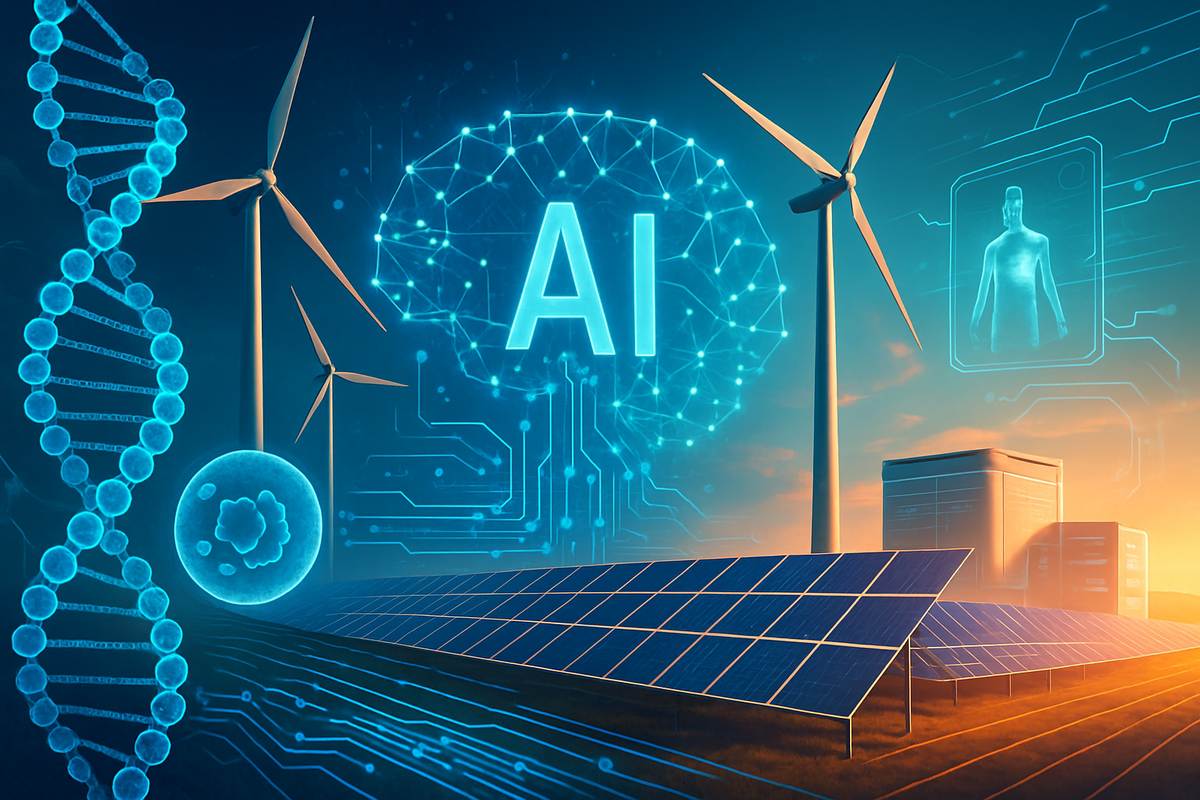
As of October 2025, the global financial markets are undergoing a profound transformation, driven by an accelerating wave of technological innovation and a pressing global imperative for sustainability. This dynamic landscape is giving rise to several high-growth sectors that are not only reshaping industries but also presenting unprecedented investment opportunities. Investors keenly observing market shifts are identifying Artificial Intelligence (AI), Clean Energy and Storage Technologies, and Biotechnology and Healthcare Technology as the vanguard of this new economic era, each promising substantial returns for those who can strategically navigate their complexities.
These sectors are characterized by rapid advancements, significant capital inflows, and evolving regulatory environments, making them fertile ground for both established corporations and agile startups. The immediate implications for the market include a massive influx of investment capital, a heightened demand for specialized talent, and a fundamental re-evaluation of traditional business models. Understanding the drivers behind these trends and their potential ripple effects is crucial for identifying the next generation of market leaders and securing a competitive edge in an increasingly innovation-driven economy.
The Dawn of a New Economic Era: AI, Green Tech, and Biotech Surge Ahead
The current market environment, as of October 2025, is defined by an aggressive pursuit of innovation across several key domains. Artificial Intelligence (AI) and Machine Learning stand at the forefront, experiencing an exponential surge in demand as businesses globally recognize its transformative power. Enterprise spending on AI is projected to see an 84% compound annual growth rate over the next five years, driven by its capacity to streamline operations, enhance customer experiences, and unlock data-driven insights. In the third quarter of 2025 alone, applied AI attracted $17.4 billion in investments, a 47% year-over-year increase. This period has seen a notable shift from foundational large language model (LLM) development to the integration of AI into practical enterprise workflows, with investors prioritizing startups demonstrating real-world adoption. Hyperscalers such as Alphabet (NASDAQ: GOOGL), Amazon (NASDAQ: AMZN), Microsoft (NASDAQ: MSFT), and Meta Platforms (NASDAQ: META) are investing trillions into the data center infrastructure required to power this AI revolution, creating an "AI-driven energy bottleneck" that paradoxically boosts demand for both traditional and clean energy sources.
Simultaneously, the Clean Energy and Storage Technologies sector is experiencing robust growth, fueled by urgent climate imperatives and supportive government policies. Innovations in solar photovoltaic (PV) technology and efficient battery storage solutions are making renewables economically competitive, often without subsidies. The International Energy Agency (IEA) projects that renewable electricity will surpass coal-generated electricity in 2025, constituting 35% of the global electricity supply. Global investment in clean energy is expected to hit a record $2.2 trillion in 2025, double the amount allocated to fossil fuel projects. This massive capital flow is driving extensive infrastructure development, including solar farms, wind farms, and critical power grid upgrades, while also emphasizing the need for resilient domestic supply chains to mitigate geopolitical risks.
In parallel, the Biotechnology and Healthcare Technology sector is witnessing rapid expansion, propelled by unprecedented scientific breakthroughs and a shift towards patient-centered care. Advances in gene editing, microbiome therapeutics, and particularly AI-driven drug discovery are revolutionizing research and clinical development. The global biotechnology market is forecast to reach $5.85 trillion by 2034, with a compound annual growth rate (CAGR) of 13.6% from 2025. After a period of market turbulence, the biotech sector is seeing an upswing in investment and a projected surge in mergers and acquisitions (M&A) activity, driven by a looming "patent cliff" that compels pharmaceutical giants to acquire innovative new therapies. This innovation, however, is met with an evolving regulatory landscape, which, while generally more flexible for AI in healthcare, also presents uncertainties due to potential policy shifts and increased scrutiny on pharmaceutical companies. The demand for specialized talent in R&D, production, and regulatory roles, particularly in precision medicine and clinical genomics, remains exceptionally high across all these burgeoning fields.
Corporate Fortunes: Navigating the Tides of Innovation
The seismic shifts in AI, Clean Energy, and Biotechnology are creating clear winners and losers across the corporate landscape, as companies either embrace or falter in the face of rapid innovation. In the AI domain, semiconductor giants and cloud infrastructure providers are reaping immense rewards. Nvidia (NASDAQ: NVDA) remains a quintessential success story, with its Graphics Processing Units (GPUs) forming the backbone of AI model training and deployment. Its data center business is the primary driver of its over $4 trillion market capitalization by July 2025. Similarly, hyperscalers like Microsoft (NASDAQ: MSFT), Amazon (NASDAQ: AMZN), and Alphabet (NASDAQ: GOOGL) are significant beneficiaries, leveraging their extensive cloud infrastructures (Azure, AWS, Google Cloud AI) to host and power generative AI models. TSMC (NYSE: TSM), the world's largest contract chip manufacturer, is also poised for years of solid growth, fabricating the advanced chips for these AI powerhouses. On the software and solutions front, companies like Palantir Technologies (NYSE: PLTR), with its AI-powered data analytics platforms, and CrowdStrike (NASDAQ: CRWD), protecting against AI-specific cyber threats, are seeing surging demand. Conversely, legacy IT service providers and undifferentiated AI startups without clear business cases are struggling, as the market consolidates around proven, scalable solutions.
In the Clean Energy sector, companies innovating in renewable generation, energy storage, and EV infrastructure are leading the charge. First Solar (NASDAQ: FSLR) stands out with its proprietary thin-film photovoltaic modules, bypassing traditional silicon supply chain volatilities. GE Vernova (NYSE: GEV) is well-positioned for the AI power surge, benefiting from increased demand for baseload power and its grid solutions business. NextEra Energy (NYSE: NEE), a global leader in clean energy, continues its aggressive investments in solar, wind, and battery storage. Companies like Bloom Energy (NYSE: BE), with its solid-oxide fuel cells providing uninterrupted power for data centers, and Plug Power (NASDAQ: PLUG), focused on green hydrogen technology, are experiencing record growth. For electric vehicles, ChargePoint (NYSE: CHPT) is consolidating its market position in Level 2 charging, while Siemens (ETR: SIE) and Daimler Buses (a subsidiary of Daimler Truck AG) are investing in advanced EV charging infrastructure. In stark contrast, traditional fossil fuel companies, such as Chevron (NYSE: CVX), face long-term headwinds as capital decisively shifts towards clean energy, with some even cutting low-carbon investments to prioritize short-term profitability.
The Biotechnology landscape is witnessing a resurgence, driven by breakthroughs in gene editing and AI-driven drug discovery. CRISPR Therapeutics (NASDAQ: CRSP), in partnership with Vertex Pharmaceuticals (NASDAQ: VRTX), is a clear winner with the approved gene-editing therapy Casgevy. Other gene-editing pioneers like Intellia Therapeutics (NASDAQ: NTLA), Beam Therapeutics (NASDAQ: BEAM), and Caribou Biosciences (NASDAQ: CRBU) are advancing diverse therapies. Pharmaceutical giants like Eli Lilly (NYSE: LLY) and AstraZeneca (NASDAQ: AZN) are benefiting from strong product pipelines and strategic acquisitions. Companies like Schrodinger (NASDAQ: SDGR) and Simulations Plus (NASDAQ: SLP), which leverage AI to accelerate drug development, are also seeing increased adoption. However, traditional pharmaceutical companies slow to integrate AI or facing a "patent cliff" without innovative pipelines, along with early-stage biotech firms with precarious finances and failed clinical trials, are facing significant challenges. The intense competition in life science tools also pressures established players without differentiated offerings to innovate or risk losing market share to aggressive acquirers like Thermo Fisher Scientific (NYSE: TMO).
Broader Implications: A Reshaping of Global Industries
The ascendance of AI, Clean Energy, and Biotechnology signals more than just sectoral growth; it represents a fundamental reshaping of global industries, with far-reaching ripple effects across economic, social, and geopolitical landscapes. As of October 2025, these trends are not merely expanding in isolation but are increasingly intertwined, creating a synergistic effect that amplifies their transformative power.
AI's pervasive growth is the central driver of broader industry trends, emphasizing automation, data-driven decision-making, and the convergence of physical and digital realms. This "AI gold rush" is reorienting capital, sparking both excitement and concern across global economies. Generative AI, having moved beyond the experimental phase, is now delivering measurable business impact and significant ROI across sectors from consumer markets to financial services. AI is rapidly becoming the new infrastructure of business, compelling competitors to accelerate their own AI initiatives to avoid obsolescence. The high cost of AI development means established companies must carefully manage investments, while consulting firms and cloud computing companies are experiencing substantial growth due to increased demand for AI-related services. Historically, this mirrors the transformative periods of the Industrial Revolution and the Information Age, with AI extending human cognitive abilities and automating processes at an unprecedented scale, though its impact on employment is seen more as job transformation rather than simple replacement.
The clean energy sector's transformative trends are driven by a global commitment to emissions reduction and unprecedented investments. Clean energy technology is set to surpass investments in upstream oil and gas for the first time in 2025, with solar PV accounting for half of all cleantech investments. This growth is fueled by rapid cost reductions and amplified by the surging power demands of AI data centers and cleantech manufacturing. The geopolitical landscape is also influenced, particularly by China's dominance in the cleantech supply chain, which is pressuring international markets and forcing companies to rethink strategies. This shift towards sustainable solutions compels tech companies making green investments to push their suppliers and partners to adopt similar practices, extending the impact beyond their own operations. Historically, this energy transition is akin to past shifts in energy sources that drove industrial revolutions, with current geopolitical tensions over supply chains mirroring historical competition for critical resources.
Biotechnology is undergoing a "biotech revolution" in 2025, significantly impacting healthcare and numerous other industries. The global biotechnology market is anticipated to grow to $4.61 trillion by 2034, driven by the expansion of gene therapy, precision medicine, and sustainable biomanufacturing. CRISPR-based gene editing tools are finding broader applications, from targeted cancer therapies to climate-resilient crops. This growth leads to significant ripple effects, with larger pharmaceutical companies acquiring smaller biotech firms to diversify portfolios and access new technologies, especially as old drug patents expire. The increasing role of biotechnology in addressing global challenges like climate change and food security echoes the impact of past agricultural and industrial revolutions. The current surge in mergers and acquisitions in biotech is a common pattern in rapidly evolving sectors, where consolidation helps integrate new technologies and maintain a competitive advantage.
Regulatory and policy implications are complex and rapidly evolving across all three sectors. For AI, the global regulatory landscape is fragmented, with the EU's AI Act introducing a risk-based approach, while the US leans towards self-governance in some areas, though an executive order in January 2025 aims to eliminate perceived impediments to innovation. Concerns about algorithmic bias, market manipulation, and environmental impact are leading to calls for greater oversight. In clean energy, the US sector faces variability due to recent federal policy shifts prioritizing domestic fossil fuel production, potentially slowing clean energy growth despite strong economic fundamentals. Globally, industrial policies and carbon-related tariffs like the EU's Carbon Border Adjustment Mechanism (CBAM) are reshaping trade strategies. Biotechnology faces a shifting regulatory environment, with a new US presidential administration potentially impacting FDA approval pathways, though an executive order in February 2025 aims to bolster oversight of independent regulatory agencies. Policies like the Biosecure Act could disrupt supply chains by prohibiting procurement from specified PRC-linked companies, leading to increased costs and altered market dynamics, while ethical considerations surrounding gene editing continue to drive calls for evolving regulatory frameworks.
The Road Ahead: Navigating Future Frontiers
As of October 2025, the trajectory for Artificial Intelligence, Clean Energy, and Biotechnology points towards continued, exponential growth, albeit with a landscape marked by both immense opportunities and formidable challenges. The coming years will demand strategic agility, sustained innovation, and proactive engagement with evolving regulatory and societal expectations.
In the short term (late 2025 to mid-2026), AI is poised for robust performance from companies providing essential hardware, software, and cloud infrastructure, with tech giants continuing heavy investment in AI-optimized data centers and custom chips. The acceleration of "agentic AI"—systems capable of autonomous decision-making and multi-step workflows—will transform industries from autonomous vehicles to financial trading. Long-term (1-5 years, late 2025 to late 2030), AI is projected to contribute nearly $20 trillion to the global economy, fundamentally boosting labor productivity. The global AI market is anticipated to reach $1.81 trillion by 2030, with some experts even suggesting Artificial General Intelligence (AGI) could emerge by 2025 or systems broadly surpassing human capabilities by 2026-2027. Companies must strategically pivot by deeply integrating AI into core operations, focusing on practical, scalable, and industry-specific solutions. This includes addressing the skills gap in specialized areas like computational neuroscience and proactively managing AI ethics, data privacy, and liability. The primary challenge remains the immense capital expenditure required for AI infrastructure, estimated at $3.7 trillion to $5.2 trillion by 2030 for global data centers, alongside navigating increasingly stringent regulatory environments and geopolitical tensions.
For Clean Energy, the short term (late 2025-2027) will be defined by a race to overcome constraints and meet escalating demand, driven by cleantech manufacturing and the energy hunger of AI. Investment continues to surge, exceeding US$2 trillion per year, with renewable energy's share in global electricity generation expected to double to 25% by 2030. Long-term (2025-2030 and beyond), renewables are expected to generate nearly 50% of global electricity by 2030, and global energy-related CO2 emissions are projected to peak by 2025. Strategic pivots involve balancing hydrocarbon returns with the pace of transition, investing in technological innovation like carbon capture and green hydrogen, and adapting to evolving grid infrastructure. Significant opportunities exist in grid modernization, corporate commitments to 100% renewable energy, and the decarbonization of heavy industry. However, challenges include geopolitical tensions, particularly China's dominance in the clean tech supply chain, high upfront costs for renewable projects, insufficient grid and storage infrastructure, and the immense energy demands of AI data centers.
Biotechnology, with a global market estimated at $1.744 trillion in 2025, is projected to surge to over $5 trillion by 2034. In the short term (2025-2026), advancements in AI and digital transformation will accelerate drug discovery and clinical trials, with significant growth expected in oncology, rare diseases, and metabolic therapies. Long-term (2025-2030 and beyond), biotechnology holds the promise of curing or eradicating many common diseases within the next two decades, driven by advances in gene therapy, regenerative medicine, and personalized medicine. Strategic pivots will involve focusing on high-potential sub-sectors, diversifying funding models beyond traditional equity, and investing in adjacent areas like diagnostics and digital health platforms. The looming "patent cliff" (over $300 billion in sales at risk through 2030) will drive pipeline diversification and strategic acquisitions. Key challenges include navigating complex regulatory landscapes, high R&D costs, ethical and biosecurity concerns, and a shortage of skilled talent. Cybersecurity threats against sensitive biotech data are also a growing concern.
The overarching theme for all three sectors is one of rapid evolution and adaptation. Success will hinge on the ability of companies to not only innovate technologically but also to strategically manage regulatory complexities, attract and retain specialized talent, and secure substantial, diversified funding. The interplay between these sectors—for instance, AI's role in accelerating drug discovery and optimizing clean energy grids—will create new interdependencies and further amplify their collective impact on the global economy.
Investment Outlook: Seizing Opportunities in a Transforming Market
As of October 2025, the investment landscape is profoundly shaped by the rapid advancements in AI, Clean Energy, and Biotechnology. These sectors are not merely experiencing transient growth but are undergoing fundamental transformations that promise lasting impact on the global economy and human society.
Key Takeaways: The past year has solidified AI, Clean Energy, and Biotechnology as cornerstones of future economic growth. The AI infrastructure market is experiencing explosive growth, with projections for 2025 ranging from $60.23 billion to $156.45 billion, and substantial capital expenditure pledges from tech giants. Clean energy investment is set to reach a record $2.2 trillion in 2025, driven by increasingly attractive economics and surging global power demand. The biotechnology sector is moving into a more "normalized" environment, anticipating increased M&A activity and improved capital access, particularly for late-stage assets in oncology and those leveraging AI for drug discovery.
Market Assessment Moving Forward: The global economy in Q4 2025 presents a complex picture. While the AI boom has propelled the current bull run, concerns about high valuations and market concentration persist. The Federal Reserve's interest rate cut in Q3 2025, with expectations for further easing, historically favors growth-oriented companies. However, persistent inflation and evolving trade policies introduce potential volatility. Within the high-growth sectors, the AI revolution is seen as larger and faster than previous shifts, suggesting a new capital expenditure supercycle, though some analysts caution about the sustainability of current valuations. The clean energy transition is deemed robust and irreversible, driven by strong economics and energy security. Biotechnology is viewed with cautious optimism, expecting continued M&A and improved capital access for companies with robust fundamentals.
Significance and Lasting Impact: These sectors represent profound, lasting shifts. AI is a fundamental, transformative force poised to drive unprecedented productivity gains, create new industries, and redefine economic structures for decades. Clean energy is critical for addressing climate change, enhancing energy security, and fostering sustainable development, fundamentally altering global energy systems. Biotechnology's continuous innovation in diagnostics, therapeutics, and personalized medicine, often amplified by AI, has a profound and lasting impact on human health, longevity, and quality of life.
What Investors Should Watch For in Coming Months (Q4 2025): Investors should remain vigilant and strategic. Closely monitor global GDP growth, inflation rates (especially how tariffs may influence goods inflation, potentially keeping overall core inflation above 3% through mid-2026), and central bank communications regarding interest rate policies. In the AI sector, watch for signs of broadening market gains beyond the "Magnificent Seven" mega-cap tech stocks, as small-cap stocks might offer more attractive valuations if interest rates continue to fall. Pay attention to the free cash flow growth of hyperscalers and the actual return on investment from massive AI capital expenditures. For clean energy, observe the pace of new electricity-generating capacity (especially solar and battery storage) coming online and monitor policy developments. In biotechnology, track FDA regulatory decisions, M&A activity, and funding rounds, focusing on companies with compelling clinical data and clear commercialization pathways. Emphasize diversification and quality, favoring companies with strong balance sheets and robust free cash flow across all sectors to weather potential economic headwinds.
This content is intended for informational purposes only and is not financial advice






